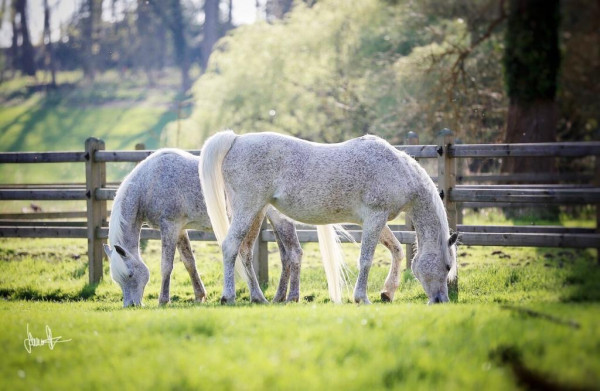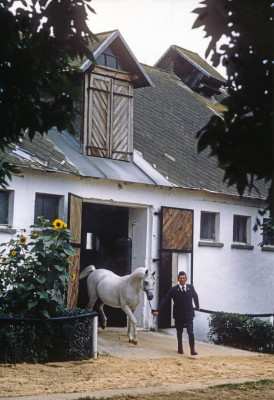Wisdom From the Breeding Shed With Rob Bick,
by Denise Hearst
The arc of trainer Rob Bick’s career is impressive in terms of the quality of the breeders and horses that he has been associated with, as well as the number of disciplines in which he has competed. Today he works for Steve and Christina Poore’s Orrion farms overseeing 135 horses that reside at their Washington farm.
“I’ve been fortunate to have been able to hang around with some great people,” says Rob. “My first job was with Murrel Lacey at John Rogers’ place. The late John Rogers was breeding durable, sound horses with the Tevis Cup in mind. The last thing they were looking at were heads.
 Rob cites the Orrion Farms’ stallion PA Kid Khan (Sundance Kid x Kharrea PGA) as one of the horses with whom a he has a special connection. “I found his sire and dam for Palmetto, and I saved him from being gelded – he is now one of the leading western sires in our breed. When I come into the barn, he is right there looking straight at me, nickering.”
Rob cites the Orrion Farms’ stallion PA Kid Khan (Sundance Kid x Kharrea PGA) as one of the horses with whom a he has a special connection. “I found his sire and dam for Palmetto, and I saved him from being gelded – he is now one of the leading western sires in our breed. When I come into the barn, he is right there looking straight at me, nickering.”
“Next I went to Texas to work as a halter trainer for Ray LaCroix. I used to sit in Dr. LaCroix’s office and talk to him about what he was after: trying to get motion and flexibility. If the horses couldn’t flex their necks and be comfortable, they weren’t going to be successful in the saddle seat classes. So that was a different deal.
“I’ve bred a lot of horses with ‘OPM’ – other people’s money."
“Sheila Varian was kind enough to send me groups of horses when I started my own business. I was amazed at how she went from Bay-Abi, to Bay El Bey, to getting Huck, then going back to Desperado V and Sundance Kid V, and then throw *Jullyen El Jamaal in there. She would breed horses and then whatever hit the ground she would promote it as the best.
“The strategy reminded me of how a lot of guys in the showring know when their horse isn’t really doing what they want it to do, but they just kind of smile like ‘I like it this way.’ That was Sheila. And that’s also good advice for people who are breeding horses."
“Frank Chisholm was the first one who came to me and said, ‘I want to breed western horses.’ This was back when nobody bred for Western"
Rob worked for Nicasio Valley when Bey Shah was there, and also also worked for DolorosaArabians. Sundance Kid V (Desperado V x Sweet Shalimar V) there stood at Dolorosa for some years, as well as the multi-champion English stallion and sire of champions Triften (Matrific x Tender Mercies). “At one point Dolorosa had four breeding programs going: halter, hunter, English and western, so that was interesting,” says Rob. “And the result was Leading Breeder at the U.S. Nationals.”
For 25 years Rob worked with the Chisholms of Palmetto Arabians as an adviser, and marketed their foal crop each year. As Rob says, “Frank Chisholm was the first one who came to me and said, ‘I want to breed western horses.’ This was back when western horses were still the ‘dropouts,’ – nobody bred for western at that time. But Frank wanted those quiet, gentle horses. He had English horses at the time, and they were hot, and they scared the crew.v
“Frank wanted horses like May Dancer V (Sundance Kid V x Magdalena V). She was western all day long, and that mare was a game changer with that beautiful neck. She set a standard for the direction western pleasure was going. She was a great horse with form to function. At Palmetto we bred some of the nicest western horses – they still show even now.
“...you have to be selling the real deal – a horse that you would like to live with."
“I’ve bred a lot of horses with ‘OPM’ – other people’s money. Experience is what you get when you didn’t get what you wanted the first time. I have a LOT of experience! And that’s what you get when you’re a horse breeder.”
With that thought in mind, here is Rob’s collected ‘Wisdom From the Breeding Shed.
1. Every horse has a value and a use. Don’t wrestle with it. He was born to do something. Figure out what it is and allow him to do it.
2. Frank Chisholm illustrates the importance of sticking to your guns. There are a lot of different styles of horses and they are all beautiful to different people on different days. Decide what you want to breed, and believe in it, and you will build a market.
3. After 45 years of training horses, a lot of people have asked me, “Should I geld my stallion?” Almost always the answer is “yes.” But eventually my answer got to be, “Do you want 100 more of him?” Because that’s exactly what you’re asking. If you don’t like him, don’t like living with him, don’t want more of him, that’s your answer. You have to have a vision of the kind of horse you want to breed – the horses that you want 100 more of.
These days if you have a three- or four-year-old and it’s not in the showring under saddle, it’s a failure. Because of these futurity and maturity programs, we’re using up these horses quicker.
4. With mares it’s a little different. Everybody assumes that all mares are breeding horses. Many mares are essentially geldings. There are a lot of mares that should not be bred.
5. Longevity matters. Some of our most beautiful horses, especially fast-growing horses, come from bloodlines that have a longevity of just 18-20 years. And they are old at that point. And some bloodlines seem to have more than their share of metabolic issues. So when they get to 18 or 20, they’ll either get laminitic or have pituitary issues. The Crabbet horses, and some Polish horses could live to 30-35. We don’t see that as much any more.
Perhaps it’s because we’ve adjusted our priorities. These days if you have a three- or four-year-old and it’s not in the showring under saddle, it’s a failure. Because of these futurity and maturity programs, we’re using up these horses quicker. And that may affect longevity. But there are a lot of horses that are great at 20-25. Take Allionce (Alada Baskin x Equitie), the park horse, for example – he was out there showing at 16, 17, 18 years of age, sound and trotting around. He lived into his late 20s. But he would never have made it in the English Futurity because he didn’t learn how to bend his neck until he was eight years old! He was a fantastic horse, but most people don’t want to wait. The horses in today’s amateur programs are all done winning their money by the time they are six.
6. Certainly disposition should be a factor in making breeding decisions. But keep in mind that a good disposition is what’s tolerable to the person who lives with that animal. When you’re going to market horses, you can’t fool people more than once. So if you want return customers, you have to be selling the real deal – a horse that you would like to live with. If you are not living with the horse and you only see it presented in a certain way, you can be taken in. And then you take that thing home and you’re miserable every day living with it…that’s not a good cycle.
7. Horses are going to grow up to be like their parents. So find a horse whose parents you like.
8. You are putting a life on the ground that is going to need a means of support. Who is going to value this horse? Are you going to keep that horse for 20 years? Or are you creating that horse to sell to someone else? You can’t just say, “let’s breed that to that and see what happens.” That is a bad plan. You need to have some planned parenthood. Let’s be responsible and try to produce a specific style of horse for this market.
Experience is what you get when you didn’t get what you wanted the first time. I have a LOT of experience!
9. Look at the physical qualities of your mare and try to match that, but also look at pedigrees. I’ve had people bring me a horse and say, “I want this horse to be a western horse.” And I’d say, “Let’s look at the pedigree,” and there is not one western horse in the pedigree.
10. One of the things that John Rogers believed was that the colts that have really nice, refined, tippy ears when they hit the ground, have a chance of being a breeding stallion. He was absolutely right. I can’t think of a consistent breeding stallion that has bad ears.
11. I don’t sell horses, I get them ready and they sell themselves. If you‘ve got one ready and it can’t sell itself because you don’t even like it, you’re going out of business.
"Longevity matters… "
12. Horses are personable. In this day and age, we don’t often get a chance to interact with animals that much. Everyone is attached to a phone. Here is an animal that is alive, thinks and breathes and makes its own decisions. It’s easy to get attached to them. Horses are more of a pet than they have ever been. Be ready to be his friend all the way to the end.

























